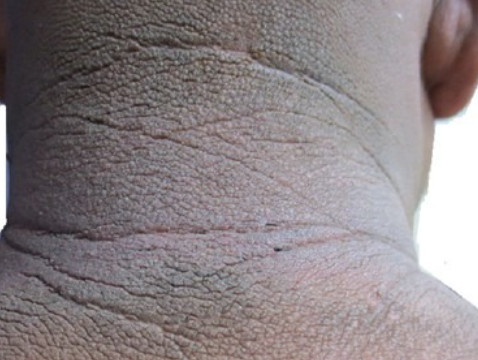Acanthosis Nigricans: History taking

- Management of patients with acanthosis nigricans depends
on the underlying cause. - Most cases are idiopathic and associated with obesity (pseudo–acanthosis nigricans).
- Most patients with AN have either clinical or subclinical insulin resistance.
- Generalized AN is very rare, and seen only in children.
Ask about :
- Age of onset?
- Since birth or during early childhood and associated with skeletal abnormalities and/or short stature : Consider syndromes like :
- Crouzon syndrome.
- Costello syndrome.
- Rabson-Mendenhall syndrome.
- Beare-Stevenson cutis gyrata syndrome.
- etc
- Early childhood : exclude familial type.
- Over 40 years of age with no hx of endocrine problems, exclude malignant type.
- Childhood or adolescence and associated with loss of subcutaneous fat: consider generalized or partial lipodystrophy.
- Since birth or during early childhood and associated with skeletal abnormalities and/or short stature : Consider syndromes like :
- Abrupt onset
- Suspect malignant type.
- Family history?
- Familial acanthosis nigricans: a rare autosomal dominant condition.
- Begins during early childhood but may manifest at any age.
- Stabilize or regress after puberty.
- History of Drugs?(Drug-induced AN)
- Nicotinic acid.
- Insulin.
- Pituitary extract.
- Systemic corticosteroids.
- Diethylstilbestrol.
- Triazinate.
- Oral contraceptives.
- Fusidic acid.
- Methyltestosterone.
- Obesity: obesity-associated acanthosis nigricans
- Search for Diabetes and other underlying endocrinopathies.
- Hyperandrogenism manifestations: Syndromic acanthosis nigricans
- Hirsutism, acne vulgaris, hidradenitis suppurativa, Irregular menstrual periods, and androgenic alopecia: exclude HAIR IN Syndrome and Polycystic ovary syndrome in female patients.
- Cushing syndrome manifestations:
- Striae
- Hypertension
- Central obesity
- Buffalo hump
- Autoimmune disease
- Acanthosis nigricans may associated with autoimmune disorders like SLE, Sjogren’s syndrome, scleroderma or Hashimoto’s thyroiditis.
- Malignant acanthosis nigricans
- Age of onset? mostly old age.
- Severe and extensive
- Mucous membrane involvement and thickening of the palms and soles.
- Itching
- Search for ( Leser–Trélat sign – Tripe palms): suggestive of malignancy.
- Weight loss.
- The most common is gastric carcinoma (ask about gastric manifestations e.g. heartburn) followed by pancreatic cancer, gynecological malignancies, and lung carcinoma.
- It may occur with, before or after the onset of internal malignancy.
- It has been detected in children with Wilms tumors and osteogenic sarcomas.
- Refer to an appropriate specialist.
- Site of affection
- dorsal hands and feet : Acral type
- Axilla
- The neck
- Scalp
- Face
- Abdomen
- Chest
- Areola
- Groin
- Extensor surfaces.
- Mucous membranes
- Unilateral or bilateral
- Unilateral: Nevoid Acanthosis nigricans.
References
#Acanthosis Nigricans #Acanthosis Nigricans History taking #Drug induced acanthosis nigricans #Familial acanthosis nigrican #Malignant acanthosis nigricans